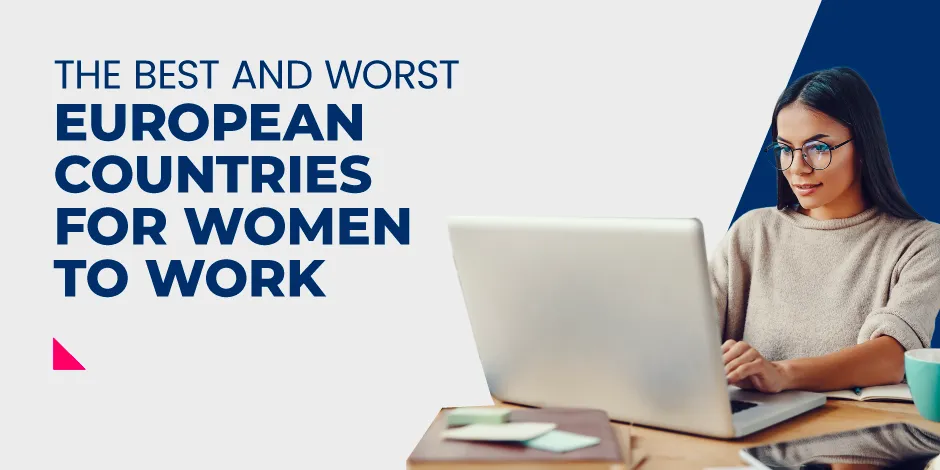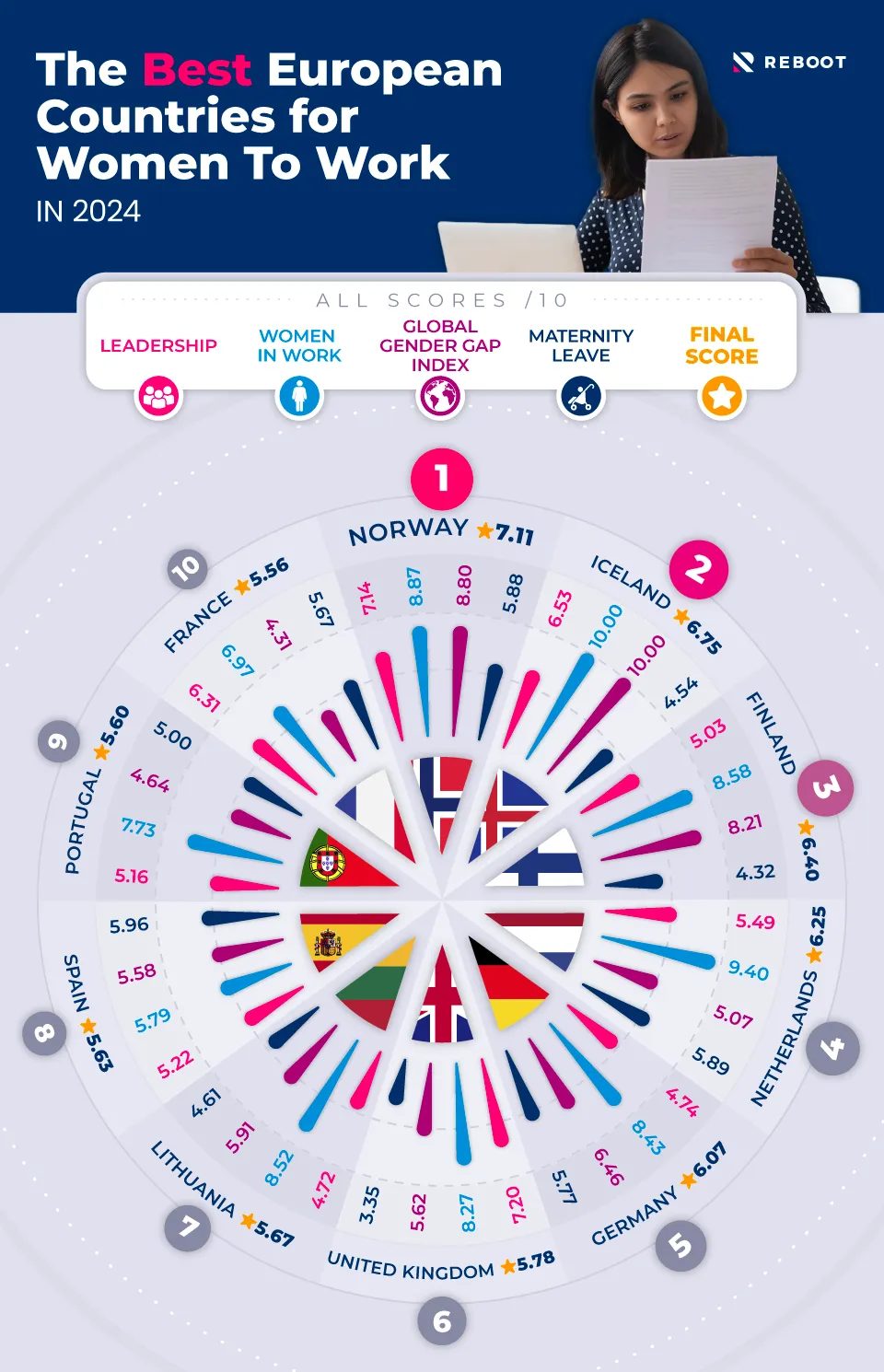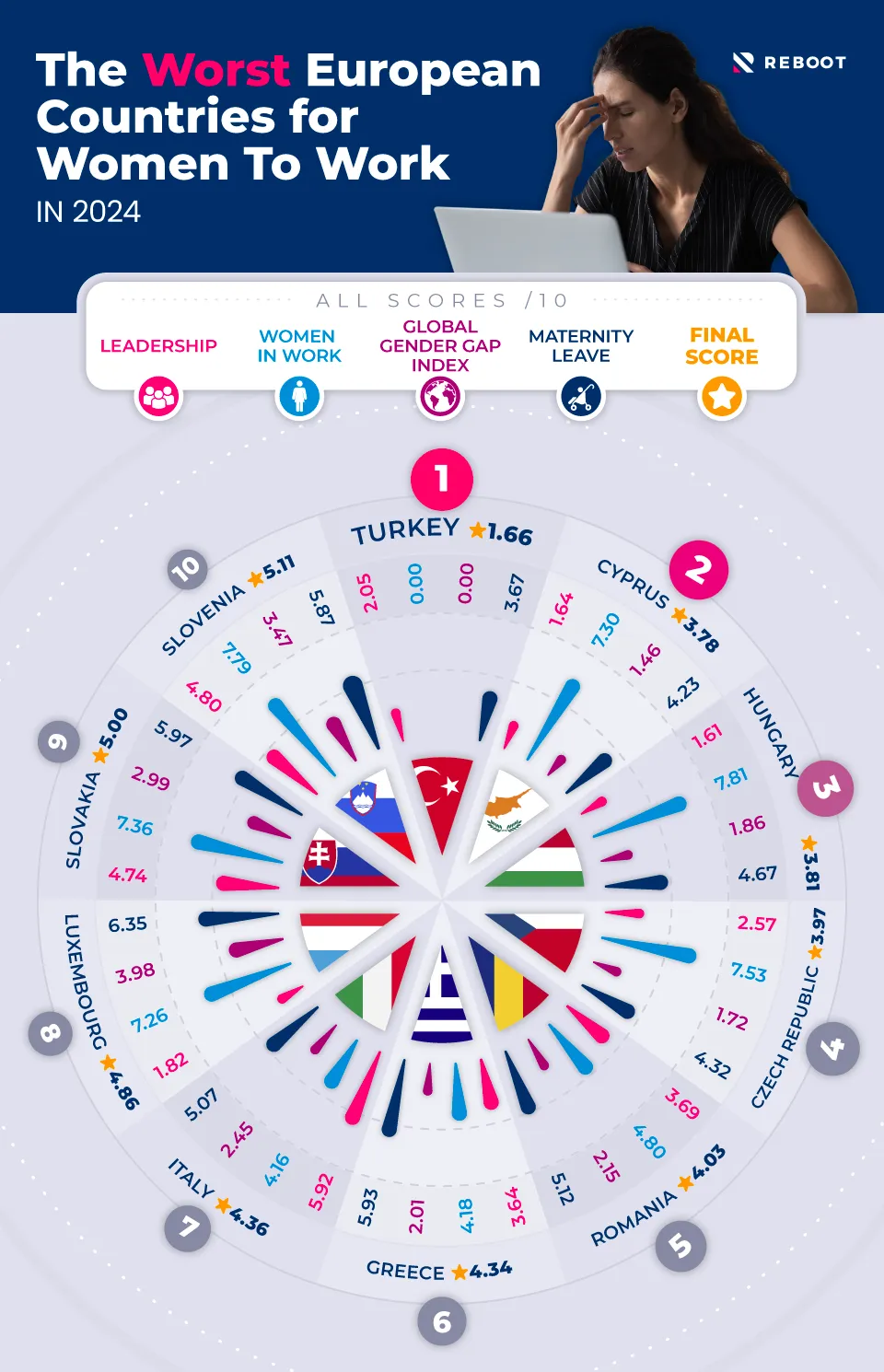
The Best European Countries for Women to Work in 2024
Working from home, trying to find a work-life balance and prioritising well-being have had many women rethinking their professional lives and reassessing their career paths. Although moving abroad for work might be an option, choosing a country to boost your career can be tricky—while some countries have greater career opportunities, others leave women feeling uninspired.
Ahead of International Women’s Day 2024, we were curious to find out the best expat destinations on the continent for women looking to pursue a career abroad.
This was achieved by creating a points-based index system, which analysed the following metrics in each country:
▪️ Female employment
▪️ Number of women in leadership roles
▪️ The Gender Gap Index
▪️ Maternity leave policies.
A final score out of 10 was calculated to assess which of the 31 European countries in our study is “best” for women to work in 2024. Keep scrolling to find out how the UK stacks up against the rest of the continent.
The 10 ‘best’ European countries for women to work

1. Norway, 7.11/10
At the top of the rankings and crowned the best country in Europe for women to work, Norway achieves an overall score of 7.11 out of 10 in our index.
Our research found that, in 2023, Norway was one of the highest-ranked countries for the number of women at work, with a score of 8.87 out of 10 for this metric. The country also has an impressive number of women in leadership roles, with a score of 7.14 out of 10.
In fact, 15% of women were CEOs and a further 15% were Presidents, showcasing high representation in top company roles across the country. We expect this to increase further over the coming years as, in 2023, the government introduced a quota for women's representation on the boards of large- and mid-sized private firms—the first of its kind worldwide.
With all of this in mind, it’s unsurprising that Norway comes in 2nd place for the Gender Gap Index (which evaluates various indicators including Work and Economic Participation, Educational Attainment, Health and Survival, and Political Empowerment), scoring 8.8 out of 10.
Norway ranks 11th out of all 33 countries in our study for its maternity policies (third in the top 10), scoring 5.88 out of 10. Working Norwegian women receive a minimum of 18 weeks of leave and are paid 96% of their income during this time.
2. Iceland, 6.75/10
Iceland was pipped to the post by Norway, scoring just 0.36 fewer points, with a total score of 6.75 out of 10.
Iceland leads globally with the highest Gender Gap Index score of all countries analysed, achieving a perfect score of 10 for both women in work and the Gender Gap Index.
Iceland also boasts notable success in the number of women in leadership roles, resulting in a score of 6.53 out of 10—the third-highest result for this metric in Europe, surpassed only by Norway and the UK.
This should come as no surprise as, in 2023, Iceland was named the most gender-equal country for the 14th year in a row, with 91.2% of the gender gap closed.
However, a fallback in Iceland’s overall score was a result of the maternity packages offered, receiving a score of 4.54 out of 10, placing the country in the bottom 10 for this metric.
3. Finland, 6.40/10
Finland secures the third spot in our index, with a score of 6.40 out of 10—a mere 0.71 points less than Norway in first.
Our research shows Finland is also taking strides towards gender parity and has demonstrated remarkable growth over the last 5 years for each metric analysed. The country stands out with the third-highest Gender Gap Index score (8.21), closely behind fellow Scandinavian countries Norway in second and Iceland in first.
Finland ranks 7th in Europe for the number of women in the workforce, achieving a score of 8.58 out of 10, and a notable percentage of these women in work hold leadership positions among some of the largest companies in the country, scoring 5.03 out of 10 for this metric as a result. It is likely that Sanna Marin, who served as the country’s Prime Minister from 2019 to 2023, contributed significantly to this progress.
The country faces a setback when it comes to maternity leave, offering women a minimum of 17 weeks of leave paid at 74.8% of their income, as well as an optional 143.5 weeks at 19% pay. As a result, they scored 4.32 out of 10—joint with the Czech Republic in this category.
4. Netherlands, 6.25/10
The Netherlands ranks fourth among the best European countries for women to work in, scoring 6.25 out of 10—a difference of 13% compared to Norway, the top-ranked country.
With an impressive score of 9.4 out of 10 for the number of women in work, the second-highest score for this metric in Europe behind Iceland, the Netherlands shines as a leader in gender equality.
Analysing the number of women in leadership roles, The Netherlands is among the top five European countries for 5-year growth. In our index, they ranked 8th for this metric, with 41% of women named as board members of the largest listed companies in the country, resulting in a score of 5.49 out of 10.
Despite this, the country ranks fairly average in the remaining two metrics, including 10th for maternity leave policies (5.89) and 14th for the Gender Gap Index (5.07).
5. Germany, 6.07/10
With just over 6 points in our index, Germany is ranked fifth among the best places for women to work in Europe.
Our research reveals that Germany is among the top 10 European countries for women in the workforce, scoring 8.43 out of 10 and surpassing the UK (8.27). Germany’s 5-year growth in this category is commendable, scoring 3.15 out of 10—a 22% difference from first-place Norway (2.52).
Despite this, Germany still has some room for improvement when it comes to women in leadership roles. Our analysis found that just 2.6% of women hold a CEO position in the country. For this metric, Germany sits mid-table in 16th 4th with 4.74 out of 10.
When looking at the Gender Gap Index, Germany takes 4th place (tying with Sweden), scoring 6.46 out of 10. Its maternity leave score leaves a lot to be desired, in 13th place with a score of 5.77—a difference of 47% from the category topper Bulgaria, who scored 9.31 out of 10.
6. United Kingdom, 5.78/10
Ranking as the sixth best place for women to work in Europe is the United Kingdom, with a score of 5.78 out of 10.
The UK tops the table for women in leadership roles, scoring 7.2 out of 10, thanks to 12% of women holding a CEO position in 2023 among the largest listed companies in the UK.
By analysing data over the last five years, we can reveal that the UK has significantly improved the number of women in high-power positions, showing considerable progress in this area compared to the rest of Europe.
The UK ranks 10th for the number of women between 16-65 in employment, scoring 8.27 out of 10, and for gender parity in the Gender Gap Index, scoring 5.62 out of 10.
However, the UK falls sharply for its maternity leave policies. Despite offering a minimum of 39 weeks of leave, less than a third (29.8) of income is paid during that time—the lowest among all countries in our study. As a result, it’s unsurprising that the UK scores just 3.35 out of 10 in this category and scores among the 3 lowest countries overall, beating Denmark and Ireland.
7. Lithuania, 5.67/10
Seventh-placed Lithuania trails the UK by a small margin, with 5.67 out of 10—a difference of just 2%.
While Lithuania doesn't score highly in leadership criteria (4.72 out of 10—a difference of 42% compared to the UK), it scores significantly better for the number of women aged 16-65 in the workforce, scoring 8.52 out of 10. This is thought to be driven by an increase in women in ministerial positions, a larger share of women in the cabinet and parliament, and the election of female Prime Minister, Ingrida Šimonytė, in 2020.
The northeastern European country boasts one of the highest scores in the Gender Gap Index, at 5.91, and narrowly misses out on the top five with Sweden and Germany, who tied for fourth place for this metric (6.46).
Lithuania’s maternity leave policy let them down and prevented them from scoring higher than the UK, ranking in 20th and scoring just 4.61 out of 10. Lithuanian women get a minimum of 18 weeks leave at 52% pay—21 weeks (or 5 months) less than working women in the UK.
8. Spain, 5.63/10
Next up is Spain who takes 8th with a score of 5.63 out of 10 in our index.
While the country scores 5.58 out of 10 in the Gender Gap Index, it performs even better for its maternity policies, scoring just shy of 6 points (5.96). This places Spain among the top 10 for maternity packages out of all 31 European countries in our study. To put that into perspective, Spain's maternity leave score differs by 56% compared to the UK, which has a score of 3.35.
Spain scores a respectable 5.22 out of 10 for the number of women in leadership roles, ranking 12th for this metric. Data analysis over a 5-year period shows that the country has made significant progress in this aspect, reflecting its commitment to promoting women to leadership roles.
However, Spain lags when it comes to the number of women in the workforce, scoring 5.79, ranking among the fifth lowest in this category in 27th place.
9. Portugal, 5.6/10
In the 9th position, we have Portugal with a total score of 5.6 out of 10 in our index study.
Of all the metrics studied, Portugal achieves moderate scores for each, ranking between 13th and 18th place across all four categories. The country fares best for women in leadership positions, though, ranking 13th across all 31 European countries and scoring 5.16 out of 10.
When comparing data over 5 years, Portugal has shown commitment to promoting women into high-power positions, such as CEOs and Presidents, making the third-best progress in this timeframe.
Portugal ranks 15th and 16th in the Gender Gap Index and for the number of women in work, scoring 4.64 and 7.73 out of 10, respectively, for each metric. However, Portugal falls short of reasonable maternity benefits, resulting in a score of 5 out of 10 and a ranking of 18th out of 31 countries for this metric. In this country, a total leave of just 30 weeks is offered, paying an average of 67.7% of income.
10. France
France rounds off the top 10 best European countries for women to work, scoring 5.56 out of 10 in our index.
Our research found that women in France have a higher chance of being successful in employment and promoted into leadership positions. As a result, with a score of 6.31 out of 10, France places 4th for this metric, just behind the UK, Norway and Iceland.
However, France loses points for its relatively low score in the number of women in the workforce, a score of just 6.97 out of 10, placing it in 23rd and among the bottom countries in this category.
Additionally, France receives average mid-table scores in the Gender Gap Index and maternity leave efforts, scoring 4.31 and 5.67, respectively.
The 10 ‘worst’ European countries for women to work
Now let’s take a look at the other end of the results. Which European country offers the least opportunities for women at work?

1. Turkey, 1.66/10
At the bottom of our index is Turkey, with a disappointing score of 1.66 out of 10. To put that into perspective, that’s a difference of 124% compared to first-placed Norway, with 7.11 points.
The Middle Eastern country only scores 2.05 out of 10 for women in leadership, marking a significant difference of 111% compared to Norway, with 7.14 out of 10 in the same category.
Astonishingly, Turkey receives a score of 0 for women in the workforce and on the Gender Gap Index. Additionally, it holds the fifth-lowest score for maternity leave among all 31 European countries, with a score of 3.67 for its 16 weeks of minimum leave—more than two-thirds (67%) of which is paid.
2. Cyprus, 3.78/10
Cyprus is the second-worst European country for women to work in after Turkey, scoring 3.78 out of 10 in our index.
The country scores even lower for women in leadership than Turkey, with a measly score of 1.64 out of 10. However, Cyprus shows improvement over Turkey when examining the number of women in the workforce. For women aged 16-65 in employment, Cyprus receives a score of 7.30 out of 10 and, positively, is among the top 10 European countries for improvements in this category.
Nevertheless, Cyprus has the second-worst score in the Gender Gap Index (1.46) and ranks seventh-worst for maternity leave (4.23).
3. Hungary, 3.81/10
Narrowly behind Cyprus is Hungary, with the third lowest score in our best European countries for women to work index, 3.81 out of 10.
Despite having an average score for the number of Hungarian women in the workplace (7.81) and ranking in 14th place, Hungary receives the lowest score in Europe for women in leadership roles. Our research found that not a single woman held the position of CEO across the top companies in the country in 2023. As a result, our index has awarded Hungary a score of just 1.61 out of 10 for this metric.
On top of this, Hungary ranks 4th worst in the Gender Gap Index, scoring just shy of 2 points out of 10 (1.86), and has been awarded 4.67 out of 10 for the maternity policies offered to Hungarian women.
4. Czech Republic, 3.97/10
In our index, the Czech Republic is the fourth worst European country for women to work in, with a score of 3.97 out of 10.
Despite the Czech Republic scoring a moderate score of 7.53 for the number of women in the workforce, when examining the number of women in leadership roles, the Czech Republic didn’t fare as well, scoring just 2.57—a 46% difference compared to Hungary (1.61). However, the country’s growth over a 5-year period in this area has been commendable, indicating some positive change.
The Czech Republic also holds the third-worst score in the Gender Gap Index, at 1.72, and ranks within the 10 worst places for maternity leave, scoring 4.32 out of 10—joint with Finland.
5. Romania, 4.03/10
Romania ranks as the fifth ‘worst’ country in Europe for women to work, with a score of 4.03.
While some figures show improvement compared to the Czech Republic, such as women in leadership (3.69), the gender gap (2.15), and maternity policies (5.12), Romania experiences a notable decline in the number of women in the workforce.
Our research found that Romania is the fourth-worst country in Europe for women's workforce participation, with a score of 4.8 for this metric in our index—four points lower than the Czech Republic in this category.
6. Greece, 4.34/10
Following behind Romania is Greece, ranking 6th with a score of 4.34 out of 10.
Greece is the ninth-worst in Europe for women in leadership, scoring just 3.64 out of 10, and the third-worst for women in the workforce, scoring 4.18 out of 10.
However, Greece shows promise when comparing figures over a 5-year period, showing notable increases specifically in the number of women being hired into high-power leadership positions and the number of women being employed between 16 and 65 years old.
Although Greece faces challenges, particularly in regard to the gender gap, resulting in a score of 2.01 out of 10, it excels in maternity leave packages on offer, ranking within the top 10 for this metric and scoring 5.93 out of 10.
7. Italy, 4.36/10
Italy falls in 7th place, slightly outperforming Greece, with a score of 4.36 out of 10.
Boasting the fifth-highest score in Europe for women in leadership (5.92) and showing marked improvement in hiring women into leadership roles, Italy sits firmly within the top 10 European countries for improvement. However, its performance in women's workforce participation tells a different story.
Italy holds the second-worst score in Europe for the number of employed women between 16 and 65 in the workforce (scoring 4.16 out of 10), which hasn’t improved over the last 5 years when crunching the numbers.
On top of this, Italy ranks poorly in the Gender Gap Index, scoring a measly 2.45 out of 10 and ranking 25th overall for this metric.
8. Luxembourg, 4.86/10
Luxembourg is the 8th worst country in Europe for women to work, with a score of 4.86 out of 10.
The country ranks third-worst for the number of women employed between the ages of 16 and 65, scoring just 1.82 out of 10. However, Luxembourg excels in women's leadership roles, scoring much higher at 7.26 out of 10.
What's noteworthy about Luxembourg is its commitment to maternity leave packages. Not only does the country pay mothers their full wage while they take leave, but it also offers one of the longest minimum periods for maternity leave (20 weeks/140 days). As a result, the country scores 6.35 out of 10, sharing its score with Poland and Estonia, placing it as the third-best in Europe for this metric.
9. Slovakia, 5/10
Slovakia comes next, in ninth, with a score of 5.11 out of 10 in our index.
The country scores relatively high for the number of women in the workforce (7.36). It also ranks among the top 10 European countries for maternity leave, with a score of 5.97 out of 10, alongside Spain and Austria who scored 5.96 for their maternity policies.
However, Slovakia lets itself down with low scores in the Gender Gap Index, scoring just 2.99 out of 10 (22nd) and 4.74 for women in leadership (17th).
10. Slovenia, 5.11/1
Slovenia rounds out the 10 worst European countries for women to work in, scoring 5.11 out of 10 overall in our index.
Although the country (just) surpasses Slovakia for women in leadership roles with a score of 4.80 out of 10, disappointingly, our analysis reveals that Slovenia has made very little progress over the last 5 years, placing the country among the three worst in Europe.
Looking closer at the remaining 3 metrics, Slovenia's scores are more middling, scoring 7.79 out of 10 for women in work, 3.47 in the Gender Gap Index, and 5.87 for maternity leave policies.
Conclusion
For many women who do decide to make the move abroad for their career, it can be a hugely rewarding experience, offering everything from the opportunity to explore a foreign marketplace to earning a higher income.
Scandinavian countries, such as Norway, Iceland, and Finland, stand out for their economic opportunities and favourable conditions, making it easier for deserving women to succeed in their desired careers.
As countries continue to commit to improving gender equality in the workforce, women will have greater prospects to excel in more European nations.
Speaking about the results of our study, our CEO and co-founder, Naomi Aharony, says:
"Our latest analysis paints a picture of both progress and persistent challenges for women in the European workforce. Countries like Norway, Iceland, and Finland continue to lead the charge towards gender equality, showcasing promising advancements. However, the stagnation of nations like Italy and Turkey serves as a stark reminder that systemic barriers still hinder women's advancement in Europe.
Despite strides forward, we cannot overlook the lingering disparities in leadership representation, pay equity, and support for working mothers. As we navigate the aftermath of the pandemic and its impact on employment, it's imperative that we prioritize policies and practices that foster inclusive workplaces and empower women to thrive professionally."
 Our Operations Director, Zoe Blogg, also adds:
Our Operations Director, Zoe Blogg, also adds:
“In today's society, women are navigating a complex landscape of expectations, grappling with the pressure to excel in their careers while often shouldering the bulk of caregiving responsibilities. This delicate balancing act remains a significant hurdle for many, perpetuating a cycle of inequality in the workplace.
It's not enough to pay lip service to gender equality; companies must actively dismantle outdated norms, advocate for systemic change and create environments where women can flourish without compromising their personal lives. Only then can we truly achieve a level playing field where every individual has the opportunity to succeed based on merit, not gender.”
METHODOLOGY
1. SEO company Reboot sought to analyse which countries in Europe are the best for Women to Work by researching female employment, women in leadership positions, gender equality gap, and maternity allowances across countries in Europe. Only countries with available data across all metrics were included in this study, with a total of 32 out of 44.
2. Data on the percentage of CEOs, executives, non-executives, presidents and board members of the largest listed companies per country in 2023 was sourced from the gender statistics database compiled by the European Institute for Gender Equality.3
3. In addition to 2023 percentages, the 5-year growth for each variable was also calculated and normalised across the countries in the data set. The 5-year growth is a measure of how well each country is doing in getting more women into leadership positions.
4. The growth score was weighted at 30% of the overall score to not unfairly punish the scores of countries with a consistently high % year on year.
5. Each factor was normalised and compared across all countries, and a final equally weighted average leadership score and growth score out of 100 was calculated.
6. The % of women between the ages of 16-65 in employment in 2022 ( latest figures) and growth was sourced from the European Institute for Gender Equality. The data for the UK was missing, so it was sourced directly from the ONS.4,5
- Note: Data for Turkey was only available up to 2020; hence, this value was considered, and a 3-year growth rate was calculated to not exclude them from the study.
7. To consider gender gaps by country, the global index score for each country in the study was sourced from the World Economic Forum gender gap index. As well as indicators for work, the index benchmarks four key issues: (Economic Participation and Opportunity, Educational Attainment, Health and Survival, and Political Empowerment). For this research, it is a measure of overall gender equality in each country.1
8. The index was renormalised for the countries in the study to compare more fairly.
- Note: The report measures women’s disadvantage compared to men and is a direct measure of equality between the sexes. Hence, gender imbalance to the advantage of women does not affect the score.
9. The report also only measures the gender gaps in access to resources and opportunities in each country and does not account for the actual level of available resources.
10. Lastly, the rights to minimum maternity leave were assessed by comparing the number of weeks of minimum leave per country as well as the % of income paid during that leave. A final normalised score was calculated and added to the final index.
11. A final average score out of 100 across all metrics was calculated to assess which of these 32 countries is best for women to work.
- The full dataset used throughout this study can be found here.